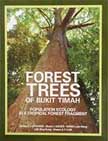
 |
| all news articles | by topics |
|
news
articles about singapore's wild places
|
| see
also Channel NewsAsia, 23 May 05 Researchers launch new book on Bukit Timah Nature Reserve By Wong Siew Ying  The
Straits Times 21 May 05 The
Straits Times 21 May 05 Same tree species in Bt Timah forest for last 5,000 years THERE are more than 10,000 of them crammed into an area the size of about three football fields, but those trees in the Bukit Timah Nature Reserve represent the endurance of Nature. A decade-long study has found that there has been hardly any change in the 320-plus species in that 2ha plot for the last 5,000 years at least, putting them possibly among the oldest in the world. The only changes have been in the actual trees themselves. Over the decades, the older ones have died, to be promptly replaced by younger generations of the same species. Otherwise, nothing about them has changed. Not the kind of wood, the shape and size of their leaves, the way they germinate, or the height they grow to. These and other findings of the study have been compiled into a book, Forest Trees Of Bukit Timah, and launched yesterday. The study, started in 1993, is being done by a group of five researchers and is a collaboration between the National Institute of Education (NIE), the National Parks Board (NParks), the Center for Tropical Forest Research of the Smithsonian Tropical Research Institute and the Arnold Arboretum of Harvard University. It is looking for answers to questions like what the major changes to the forest have been and how these could help better manage the resource for future generations. The 178-page book also contains detailed information of the forest trees found in the area - their size, growth rates and flowers - and includes detailed sketches of their leaves. One of the five authors of the book, Dr Stuart Davies, said the study revealed that the forest has a particularly high turnover rate compared to others in the region. He added that the team is now trying to understand why this is so and why the turnover rate has not affected the diversity of the species there. The area will be studied for at least 15 more years to gather more conclusive information. Launching the book yesterday, Second Minister for National Development Lim Swee Say said it made sense to preserve such a heritage. 'Our rainforests are important assets in terms of their natural heritage and biodiversity of flora and fauna.' The Bukit Timah Nature Reserve is one of four here. It, together with the Central Catchment Nature Reserve, the Sungei Buloh Wetland Reserve and the Labrador Nature Reserve, cover more than 3,326ha, about the size of 5,000 football fields. Channel NewsAsia, 23 May 05 Researchers launch new book on Bukit Timah Nature Reserve By Wong Siew Ying SINGAPORE : The Bukit Timah Nature Reserve, one of the oldest reserves in Asia, is also home to some of the most diverse flora and fuana. A decade-long research study of the reserve has found that the forest is undergoing some changes, and these findings have been compiled into a new book. Some 400,000 visitors trekked through the Bukit Timah Nature Reserve last year, and the high traffic has had a big impact on the forest. The findings will help NParks find ways to better manage the reserve and keep track of its changes. But it pays for Singaporeans to know more about the 165-hectare Bukit Timah Nature Reserve as well. Said Dr Stuart Davies, director of the Centre for Tropical Forest Research, "The average Singaporean drinks water every day and approximately a third of their drinking water comes from the catchments fed by the nature reserve. The second reason is we all live in Singapore and we live in this incredibly built up city and you need a place to relax and get clean air." Dr Davies along with a team from the National Institute of Education have published the findings from their 12-year study at a two-hectare plot. There, they found over 320 species of trees, making the reserve one of the most diverse forests in South East Asia, after those in Malaysia and Indonesia. They found that the life span of trees was shorter but the diversity of the species had remained fairly stable. The researchers conduct a census at the two-hectare site once every three years to monitor the dynamics of the forest and the composition of its species. Going forward, they also hope to expand the survey plot and use the findings to restore degraded areas in the forest. The team is also working with NParks to grow native species around the Bukit Timah Nature Reserves to protect the primary forest. links More about Bukit Timah Nature Reserve Related articles on Singapore's biodiversity status, threats, commercial applications of biodiversity |
| News articles are reproduced for non-profit educational purposes. | |
website©ria tan 2003 www.wildsingapore.com |